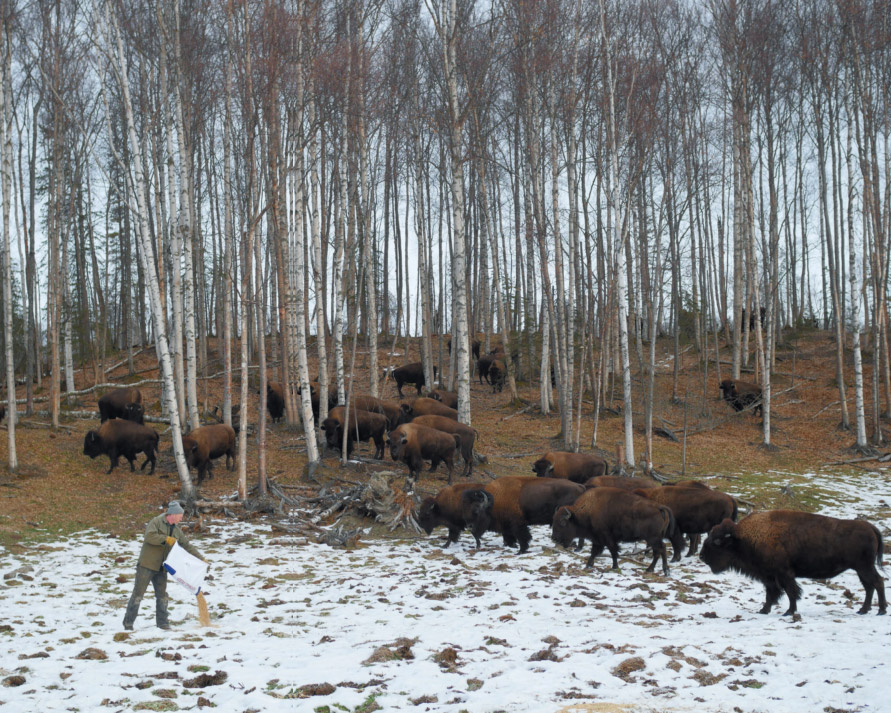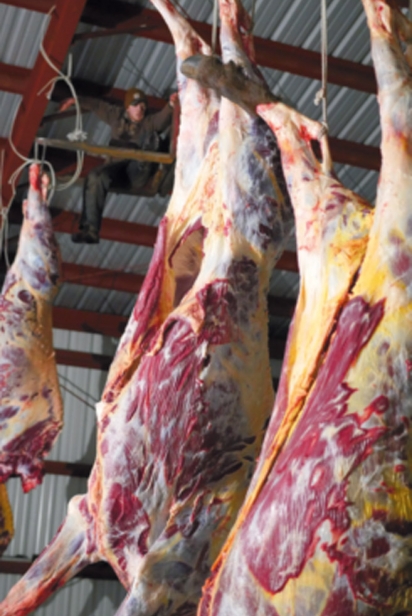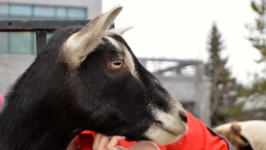The Boyd Family Bison Farm
For the Boyd family, raising livestock and helping others isn’t just a hobby or a job — it’s a calling that has been passed down through three generations on their agricultural oasis in Palmer, Alaska.
Over the years, the family’s acreage (formerly known as Mat Valley Potato Growers) has taken many forms. Some years it’s been fields of hay and potatoes. It’s also been home to many animals, hooved and feathered, but perhaps none as unique as their herd of plains bison.
Why bison? Adam Boyd, head of the Boyd household and primary bison caregiver, says it’s about self-sufficiency, the health of the meat, and partially just about the challenge.
“Bison are smart, very alert. Much more so than cows,” said Adam. “They’re interesting to be around. I have a deep respect for bison.”
With a herd of about 40 plains bison — the breed you’d find in the Dakotas and Midwest states — fenced on a massive, partially wooded, partially open field, Adam says it’s his love of animals that drives his desire to continue with bison rather than other meat animals.
“I think anyone who’s been around livestock and raised livestock, it’s a reward that you feel good about. Sure, there’s the self-sufficiency angle, but that’s not what it is so much for me. I enjoy being in the company of animals.”
From Beef to Bison
“Growing up, Dad and I always raised beef calves,” Adam said with a touch of nostalgia, thinking back to what the farm looked like 40 years ago. “Everyone who didn’t get a caribou or moose during hunting season would come out to the farm here to get a cow to fill their freezer before going into winter.”
As the family business started seeing more success financially by growing crops, they continued increasing their farmable land for planting vegetables, mostly potatoes. Those expanding potato fields took over what was previously cow grazing pasture. As they tilled up acre after acre in exchange for hay fields and potatoes to accommodate local demand, the cattle slowly went by the wayside. But even then, Adam knew it was only a matter of time before he found an opportunity to raise livestock again.
One day, a friend who was raising bison in the Lower 48 called him and said he should think about it, too. At that time, Adam had never considered raising bison, but it was intriguing to him. The idea marinated in the back of his mind for the next few years, waiting for the right time to pursue it. That right time came in the form of a herd of bison as payment for hauling services.
“A farmer out at Point MacKenzie was bringing in bison for himself out of Alberta, and hired me to do the hauling. I said, ‘You know what, why don’t you put down 10 bred heifers on there for me and I’ll do all the hauling and trucking for free?’”
Adam trucked a sizable load of bison for the farmer, and brought home 10 for himself. Within a few months, all of his bred heifers birthed calves, bringing his herd up to 20 bison.
What’s more fun than hauling a herd of bison cross-continent? Trying to find a superior breeding bull in Alaska to ensure genetic diversity in your animals. “That was the biggest chore. I really lucked out finding someone in Nikiski who had a bull plains bison for sale. That’s how it all tied together.”
More Wild Than Tame
With lower fat and cholesterol than beef and fewer “factory farms,” there’s certainly a demand for bison meat. But raising bison — an animal more wild than domesticated — isn’t for everyone. “Everything in life is dangerous to a point, so it depends on your definition,” said Adam boldly. Adam has never been one to shy away from hard work or the threat of a few bruises. He considers it a challenge — something to keep him on his toes. “Bison are what they are. Unpredictable. Alert. You just don’t know what they’re going to do or when they’re going to do it, so don’t put yourself in a bad spot. If you know you have an aggressive animal, always be aware of where they are, and give yourself an escape route.”
In general, bison spook easily and don’t like to be around people. From time to time when Adam is in their pen cutting downed trees into firewood, they’ll come over to check him out. But it’s always on their terms, on their schedule.
During rut season when the bulls are getting ready to mate, that’s when you need to stay extra aware of your surroundings. “I’ve been in there with a bulldozer taking down some trees and had bulls square off with the dozer. They’ll smack their head on it, trying to pick a fight with it. You just shut the machine down so they don’t hurt themselves. Let them work through their temperament and wait until they go about their business.”
While the males get seasonally aggressive, the females have their annual traditions, too: birthing season. During calving time, the female bison will disappear from sight, hiding together in the thick woods to form a nursery, soon to re-emerge with babies.
In the 17 years that the Boyd family has been raising plains bison, there have been plenty of close calls, but only one physical hit. Adam had been actively trying to build a trusting relationship with the herd’s lead female bison, and it seemed to be working. Around Adam, she was calm. Earning a comfort level with the lead female made the rest of the herd mellower when he was nearby. He had even successfully hand-fed her grass.
“Then I was pouring grain one day, and she thought I was pouring too slow. I got lifted up off my feet and smacked into the fence. She bounced me off the wire. She wasn’t mean about it. She was just telling me I needed to hurry up. I thought I had tamed her down. I learned you can’t tame bison. They’re more wild than they are domesticated, but that’s what I like about them.”
Horse High, Hog Tight, Bull Strong
Q: What’s the one thing that a bison farmer in Alaska loses sleep over?
A: Fencing.
Even at 6-feet high, occasionally an animal will try to jump the fence. As soon as the Boyds spot a bison attempting to leap, that animal will be added to the list of fall butchers. Bison are smart, and you can’t have one teaching the whole herd how to escape. With rotating 50-acre pens, it’s difficult enough maintaining fence patch work and building up for snow drifts.
Winter is undoubtedly the hardest time of year for keeping bison, with heavy snowfall and strong winds creating feet upon feet of snow drifts — effectively dwarfing the once-suitable fence line. The Boyd’s fence is 6-feet tall at low points, 18-feet tall at high points. “If you want to sleep at night, you better have a tall, strong fence line. The old expression is horse-high, hog-tight, bull-strong.”
Much of the bison grazing pasture has tree cover. When Palmer has especially snow-heavy, windy days, it’s only a matter of time before a tree comes down on the fence or the wind creates new snow drifts. But none of these obstacles are new to the Boyds.
“There have been times when we’ve had to put a welder and generator on a pickup hood, driving alongside the fence while cutting steel extensions, welding them on the wire. You’re standing up on a pickup, on a snow drift, and you’re probably 6-7 feet high as you’re trying to get new fence up. That’s why there are some sections of the pen where the fence is 18-ft high. Because that’s where the wind blows. You can’t fight mother nature, so you have to learn how to work with her.”
And what do you do if your bison are still able to escape from their enclosed pasture?
“You can lead bison, you can’t herd them. If they escape in the winter, you get close to them with a tractor, because they’re not afraid of the tractor. Then you walk down the path shaking a bag of grain, pouring little piles as you go. They’ll start following you. Then you find out how fast you can run with a 50 lb. bag of grain, as you’ve got 1800 lb. animals on your heels.”
One of Adam’s favorite parts about butchering bison compared to other meat animals is appreciating their unique design. Their lungs are twice the size of a cow or a horse. That enormous lung capacity gives them the ability to run for miles, further cementing Adam’s belief that you can’t “herd” bison. They’re faster than you are, and they’re physically better equipped.
Health Benefits of Bison Meat
The Boyd family’s bison graze in densely wooded pasture in the summer. It seems the only vegetation they won’t devour are stinging nettles and devil’s club. In the winter, once the land’s natural underbrush and grasses have died and are buried deep in the snow, the herd fills their bellies with dried hay bales from the summer hay fields.
Hay season in the Boyd family is a special time of year, when family and friends work together to cut and put up massive 1400 lb. round bales from sunup to sundown. Under Alaska’s summer sun, it’s common for the Boyds (and a few dedicated family friends) to be working in the hay fields past midnight. And when you own a herd of bison that can eat 1½ round bales of hay per day in the winter, all of that hard summer work is necessary.
“I don’t like to use the word ‘organic’ because that definition means different things to different people, but it’s definitely a healthier, cleaner way of life,” Adam says of his bison meat. “Most of the beef people eat has been so mass produced. You don’t know what goes into it with these huge operations.”
While many cattle farmers rely on antibiotics to keep their herd healthy, Adam says that’s where bison meat is king. “I’ve raised cows for a long time. Bison are much more self sufficient than cows. I feed them, I fence them, that’s about it. You’re not pulling calves, you’re not dealing with antibiotics. They don’t need it. Everybody wants to eat something healthy, something clean. Mine are grass fed, no antibiotics.”
The biggest challenge with switching from beef to bison is learning to cook it properly. Cuts of bison don’t have fat marbling the way that many beef cuts do. Similar to a moose steak, bison is so incredibly lean that’s it’s easy to overcook until you get the hang of it. That balance of low-fat, low-cholesterol, high-protein is exactly why bison meat is becoming increasingly popular. Each fall, they harvest 6-8 animals and sell out before they even start butchering.
With land that has changed guard from cows to potatoes to bison, it’s anyone guess what the years ahead will bring, and how the farm will continue to evolve. But Adam’s passion for animal husbandry will likely stay a focal point of the farm for the foreseeable future.
“I think generation to generation you do what your folks did. You tweak it, modify it, twist it a little bit to make it your own. Raising animals makes me feel like I’m a part of a bigger thing. There’s something to be said for being able to take care of livestock. They’re dependent on you, you’re dependent on them. You all exist for a purpose.”







